The first thing you’ll notice when you look at any duck is their plumage. Ducks have waterproof feathers. The feathers are so water resistant that they can dive underwater and come out with their body staying dry.
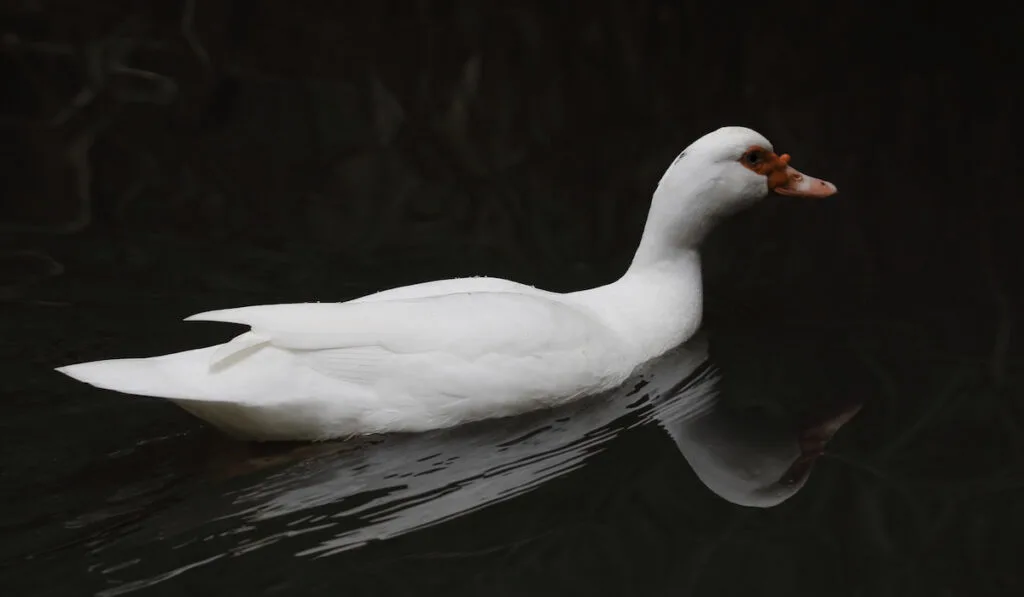
Although having water-resistant plumage is a feature common to all ducks, the pattern, arrangement, color, and texture of their plumage differ across breeds.
Duck plumage comes in various colors: black, white, green, brown, beige, blue, and many more. Let’s take a closer look at duck breeds that are known for their white plumage and how they are similar (or different) from one another.
Table of Contents
1. Call Duck
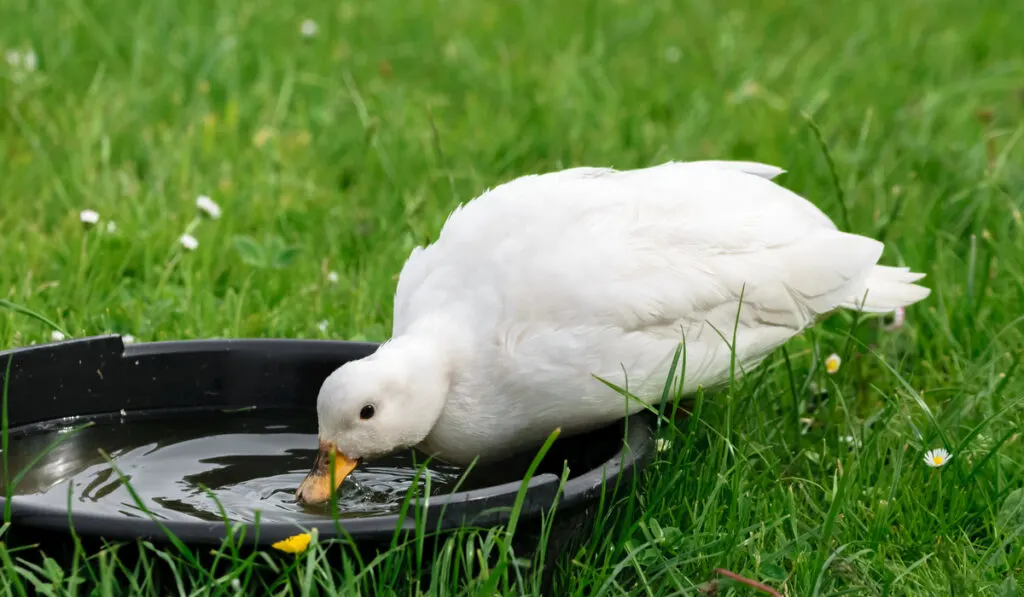
The Call duck is the smallest domestic duck breed. They originated from the Netherlands and were used as coy or decoy ducks.
Call ducks are cute, friendly, and lively. These features make them great as pets and for ornamental purposes. They have white plumage, short bills, and short bodies with an average height of 13.5 inches.
The Call duck breed comes from Mallard ducks. As ducklings, Call ducks have yellow plumage. But after 8-12 months, they reach adulthood and their plumage changes color, usually to their trademark white. The wings of Call ducklings mature for flight within 50-60 days.
Call ducks reproduce quite fast; their eggs have an incubation period of approximately 30 days. They are omnivorous and enjoy eating insects, worms, grains, and roots.
2. American Pekin
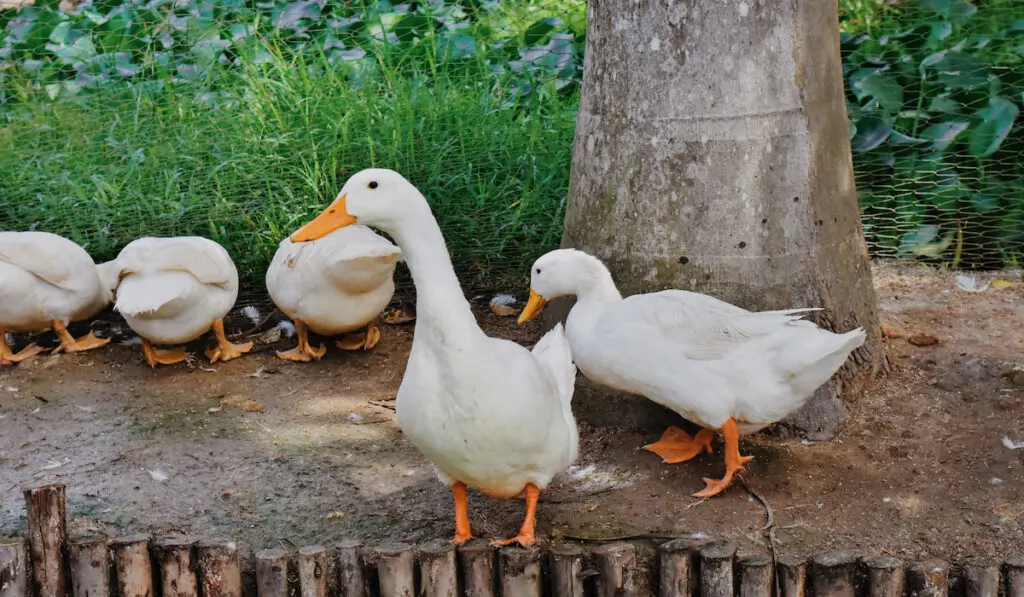
They might be called American Pekin, but these ducks came to the United States from China in the 19th century. This breed is available all around the world, and it is one of the largest domestic ducks.
American Pekins have been bred selectively over the years to lay large eggs and increase their meat production. For this reason, they are largely kept for their eggs and meat.
American Pekins may also be kept as pets. They are warm, friendly, and calm. They have a great immune system, and this helps them survive in harsh conditions. Still, you should avoid exposing them to extreme conditions deliberately.
Pekins have white plumage with orange beaks and feet. They are omnivorous dabbling ducks, and in the wild, they eat nuts, seeds, berries, algae, frogs, and small fish.
If you have a domestic American Pekin, you can let it forage while you give it poultry feed.
American Pekins lay as many as 200 eggs every year. Their eggs are usually white or tinted, and it takes about 28 days for them to hatch. You are unlikely to find a Pekin sitting on her eggs, so you may have to incubate the eggs yourself.
3. German Pekin
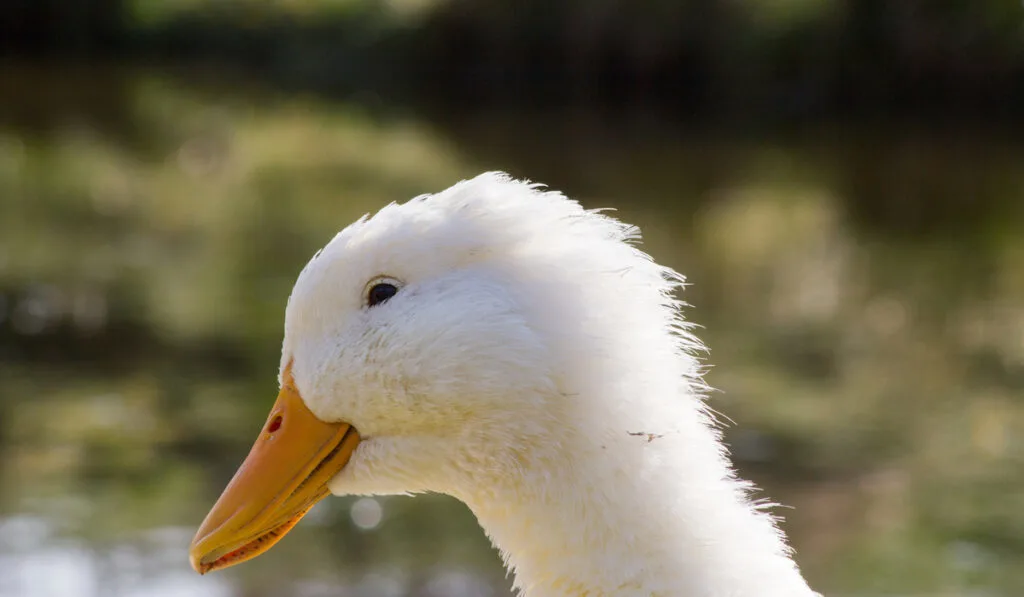
The German Pekin differs from the American Pekin. Although they both come from Mallard ducks, their breeding and appearance differs.
The American breed comes from Mallard crossbreeding with the British Aylesbury duck.
On the other hand, the German breed comes from crossbreeding with upright white Japanese ducks.
Because of these breeding differences, the German Pekin has a steeper body angle relative to the American Pekin.
In the past, German Pekins were reared for their meat. But they have not been kept for agricultural purposes since World War II.
German Pekins are currently listed as seriously endangered. They are mainly kept for ornamental purposes and as pets.
4. Mulard

The Mulard (also Moulard) comes from crossbreeding between the Domestic Mallard and the Domestic Muscovy.
Although this crossbreeding can occur naturally, it is commonly achieved through artificial insemination.
When breeding a Mulard, the American Pekin is commonly used. American Pekins are a type of Mallard and are known for their high meat and egg production.
When a Mulard is bred from a Muscovy drake and Pekin duck, it is called Mulard or Moulard. When a Mulard is bred from a Pekin drake and a Muscovy duck, it is called a Hinny. Hinnies are usually smaller in size.
Mulards are sterile since they result from crossbreeding with mallards. They are usually reared for their meat and for foie gras.
Eggs produced from Mallard and Muscovy crossbreeding have an incubation period of 32 days. Roughly 50% of these eggs hatch to producce Mulard ducks.
Mulards can have pure white plumage or white plumage with colored spots. They have pink or bright orange bills with yellow or bright orange feet.
5. Aylesbury Duck
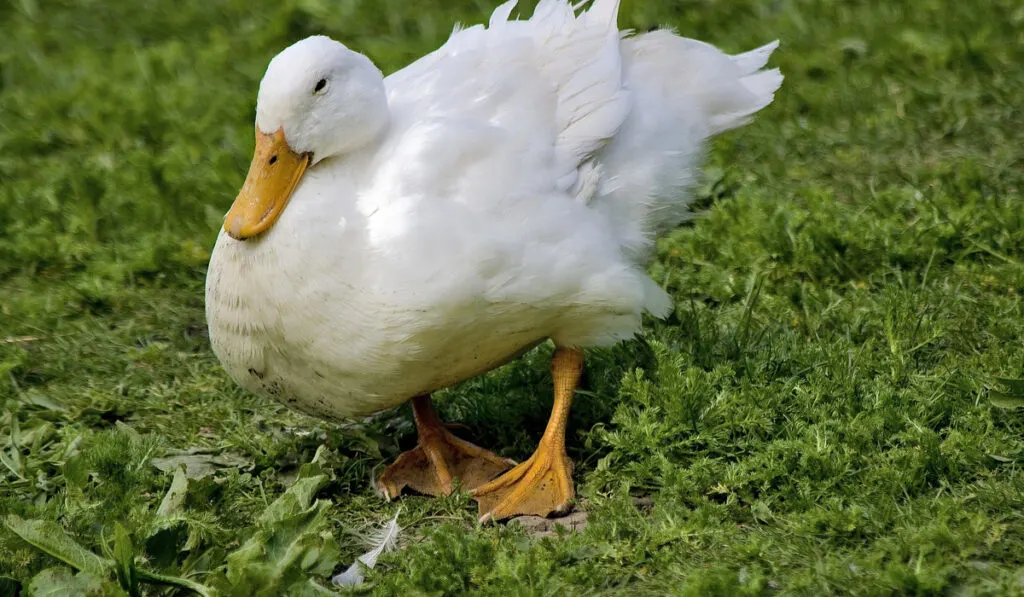
While its exact origins are unknown, the Aylesbury duck takes its name from the region of Buckingham, England where the breed was popularized in the 19th century.
Aylesbury ducks became a favorite since they are fast growers and regular egg producers. These ducks are known for being large with a light bone structure, having mild-flavored meat, and laying eggs even during winter.
Aylesbury ducks have pure white plumage, long pink bills, and bright orange feet. Their necks are long and thin similar to a swan.
The rearing of Aylesbury ducks started declining at the start of the 20th century. This decline was triggered by the introduction of Pekin ducks in Britain toward the end of the 19th century.
Aylesbury ducks were introduced in the United States in the mid-19th century but never became popular. Currently, this breed is critically endangered in the US. Aylesbury Ducks are domesticated and kept for meat and ornamental purposes.
6. Bali Duck
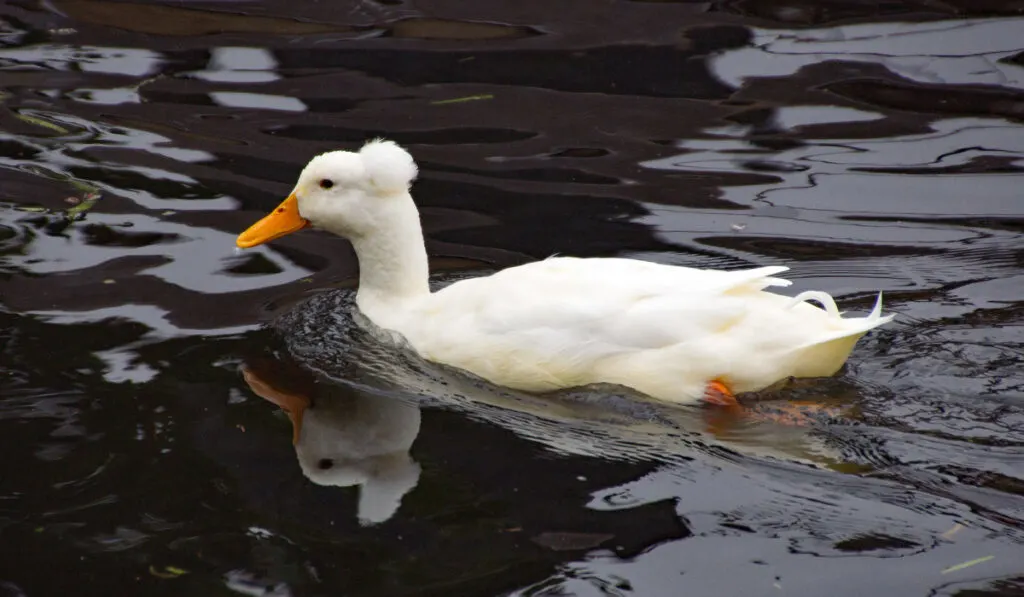
Bali ducks (also called Balinese Crested ducks) are native to the Island of Bali in Indonesia. This breed is one of the oldest domestic duck breeds.
Bali ducks are great egg layers; they lay between 120 and 250 eggs per year. Despite this, they are not commonly kept for commercial purposes. They are small in size and not considered a great source of meat.
Bali ducks are primarily kept as pets or for ornamental purposes. Bali Ducks are friendly, and make a great addition to a farm or a family.
Bali ducks are quite similar to Indian Runner ducks; the difference in appearance between both is the crest atop the head of Bali ducks.
Bali ducks commonly have pure white plumage, a bright orange bill, and orange feet. Their eggs are blue-green to white with an incubation period between 26-28 days.
Bali ducks are omnivorous. Let them forage, and they’ll eat insects, worms, grains, seeds, and other natural foods. If you are raising Bali ducks, you can enhance their forage with duck feed or poultry feed.
7. Bourbourg Duck
The Bourbourg duck, also known as Canard de Bourbourg, is a domestic duck breed with origins from the city of Bourbourg in the south of France.
These ducks are large, have white plumage, a pink beak, and orange legs. Bourbourg ducks are mainly kept for their meat, although owners can also benefit from their eggs. On average, they lay over 50 eggs per year.
Around the mid-20th century, Bourbourg ducks were at risk of disappearing. They were bred with other duck breeds, but the crossbreeding did not favor them.
Thanks to the efforts of breeders, their population has been on the rise since 1998.
8. White Crested Duck
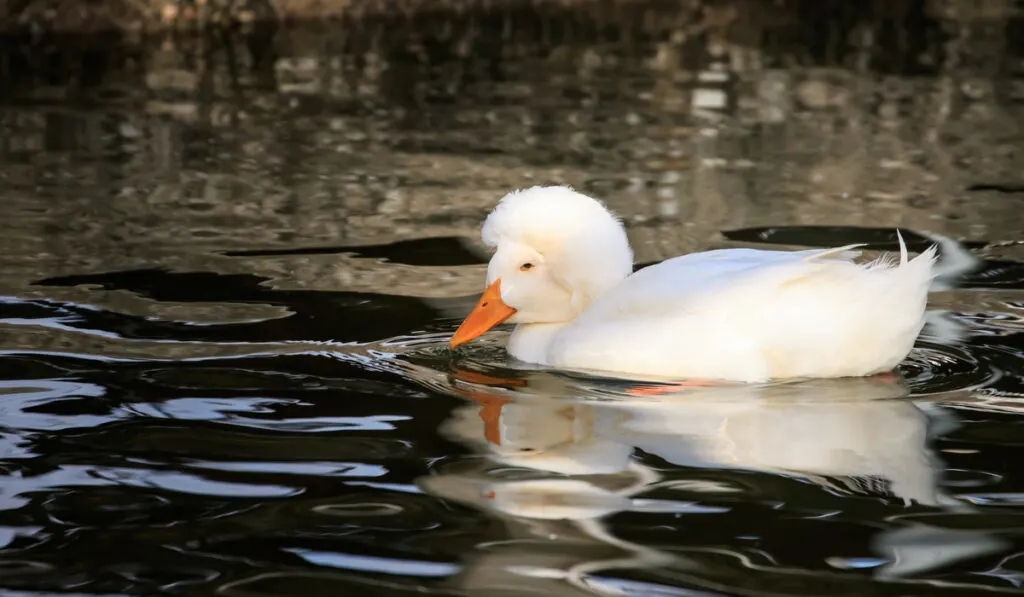
Crested ducks date back to the 17th century, but there’s no firm consensus on their origins. Crested ducks were brought to the United States in the mid-19th century.
Crested ducks are non-migratory birds. They come in various colors, but White Crested ducks have long pale-orange bills and legs and are recognizable with their fluffy white plumage.
White Crested ducks can appear similar to Pekin ducks. But the exaggerated large crest on top of their heads makes them stand out.
They are usually kept as pets, but they can also be kept for their eggs and meat. On average, White Crested Ducks produce between 100-130 eggs every year.
Resources
- https://www.allevamentopoggiodiponte.com/our-breeding/ducks/farmyard-ducks/call-duck
- https://www.four-paws.org/campaigns-topics/topics/farm-animals/10-facts-about-ducks
- https://pethelpful.com/farm-pets/pekin-ducks
- https://livestockconservancy.org/index.php/heritage/internal/aylesbury
- https://www.breedslist.com/bali-duck.htm
- https://www.roysfarm.com/bali-duck/
- http://www.enrx.fr/Ressources-genetiques/Le-patrimoine-animal/Les-races-regionales-et-leurs-actualites/LE-CANARD-DE-BOURBOURG
- https://www.cooksinfo.com/bourbourg-duck
- http://afs.okstate.edu/breeds/poultry/ducks/crested/index.html/
- https://www.purelypoultry.com/white-crested-ducklings-p-617.html
